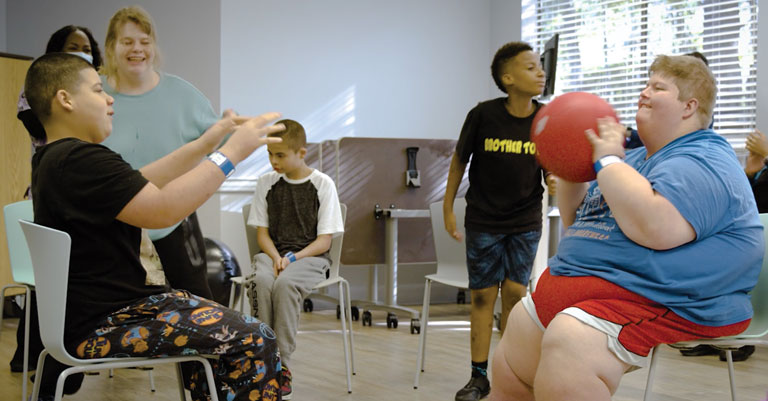Since Prader-Willi Syndrome (PWS) was first identified in 1956, management strategies have been developed to address the complex cluster of symptoms associated with the disorder. The rapid weight gain, constant craving for food, learning difficulties, and behavioral challenges that characterize PWS can be managed with therapy, reduced-calorie diets, exercise, and medication.
What’s missing from the literature is a comprehensive look at improvements in body composition, physical activity, and key health markers over time among children who receive care. In the Jump Start Program at Nexus Children’s Hospital, John W. Cassidy, MD, and Geethanjali Ravindranathan, MS, are conducting a study that will inform optimization strategies for pediatric inpatient PWS treatment.
An ideal setting for a longitudinal PWS study
Nestled in the heart of The Woodlands, the Jump Start Program offers the only inpatient programming in the U.S. for children with PWS. In 2023, 53 patients were admitted to the program. On average, they stayed for 154 days and decreased body mass index (BMI) by an average of 16.4%.2
The success of Nexus’ Jump Start Program is attributable, in part, to the years of expertise reflected in the programming. Patients are immersed in a specialized therapeutic milieu, or environment, and adhere to a highly structured daily schedule of events and activities. Significant focus is dedicated to maintaining a consistent routine, which helps patients feel more secure about the availability and timing of meals. Basic behavioral conditioning in the form of a token economy reinforces positive behaviors and helps clinicians track progress.
Perhaps most importantly, the Jump Start Program features a fully embedded interdisciplinary team. Experts include pediatricians, a child and adolescent psychiatrist, a board-certified dietician, a pediatric nursing staff, certified nursing assistants, behavioral coordinators, licensed clinical social workers, and a range of direct care therapists.
The method behind the study
The idea behind this study was simple: to gather data from consenting Nexus patients in order to optimize future treatment approaches. 30 patients are currently participating in the program. To conduct statistically significant analyses, the researchers need data from at least 100 patients from admission to discharge.
“Right now, we’re doing the study at a high level,” Ravindranathan said. “We’re just observing and collecting data. Eventually, we want to dive deep into each patient’s profile and link data to their medications, co-existing conditions, and other relevant differentiators.”
Researchers begin by taking baseline measurements of key markers upon admission, then gather data at regular intervals throughout the patient’s stay at Nexus. Every week, patients step onto the InBody scanner – an advanced scale that uses bioelectrical impedance analysis (BIA) to measure body composition by sending small electrical currents through the body. These currents travel through muscles, fat, and water, producing impedance readings that measure more than 20 markers – including body fat, muscle mass, and water weight.3
“The kids get excited about their weekly scans,” Ravindranathan said. “It’s a fun activity for them. The InBody actually prints out results immediately and gives them a graph of their progress.”
Fitbit Inspire 3 devices also track several metabolic markers, including heart rate, steps, calories burned, and skin temperature. In addition to providing valuable data, the smartwatches offer an additional layer of motivation. Each week, patients are given a step goal during a morning walk. If they reach their goal, they receive “behavior bucks” (the currency of Jump Start’s proprietary token economy). As a control, patients are given the same goal at another time during the week, but without the incentive of reward. Though data has not yet been analyzed, Ravindranathan hypothesizes that connecting the metrics with reward will have a positive impact on patient outcomes.
Collecting data, one patient at a time
Given the size of the Jump Start Program and the average length of stay for each patient, collecting a statistically significant dataset will take time. By September 2024, Ravindranathan expects to have complete profiles for 30 patients, at which point the researchers plan to review and publish the pilot study’s findings. Future metrics of interest will be determined by changes observed among this small population.
Since PWS patients present a range of complex behavioral and medical conditions, there are many relevant markers to track. Skin-picking, for example, is a common behavioral challenge for which multiple pharmacological interventions have been proven effective. With enough data, researchers hope to identify which patients are likely to respond well to certain medications based on their unique markers. In this way, the study will help to optimize care for each patient. The research team plans to present its preliminary findings at the 53rd Annual Meeting of the Child Neurology Society in November 2024.
Know someone in need of inpatient PWS care?
The Jump Start Program offers a structured inpatient environment in which patients receive the medical care, support, and guidance they need to reach weight loss and overall health goals. Using evidence-based medicine and recognized outcome measurement tools, we address both behavioral and medical needs. Contact us to refer a patient.
Sources:
1 What is Prader-Willi syndrome? | Foundation for Prader-Willi Research
2 2023 Quality Overview for Nexus Children’s Hospital | Nexus Health Systems

